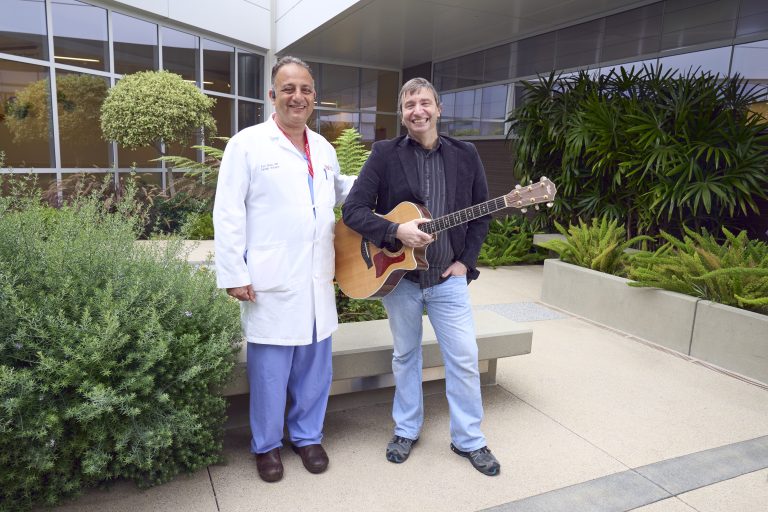We sat down with the leaders of the three institutional entities that comprise the Cedars-Sinai Health System: Thomas M. Priselac, president and CEO of Cedars-Sinai Health System; Craig Leach, president and CEO of Torrance Memorial Medical Center; and Lori J. Morgan, MD, MBA, president and CEO of Huntington Health. Hear about what our affiliations mean to them, in their own words.
Each of you was somewhat familiar with the other two institutions prior to the affiliation, but has there been anything new that you’ve learned about the other institutions since joining Cedars-Sinai Health System?

Craig Leach: Through the affiliation, we have seen that the culture of Cedars-Sinai is very, very similar to the culture of Torrance Memorial Medical Center—a focus on respect for one another, a focus on being excellent at what we do and a focus on our community. Before the affiliation, I always thought of Cedars-Sinai as being this large academic medical center that focused way beyond being a community hospital. But I’ve come to see that, in addition to its role as a national academic medical center, many people rely on Cedars-Sinai as their community hospital

Lori Morgan, MD: I agree. The affiliation provides that aspect of getting to know the other institutions’ leaders and finding very significant alignment with Torrance Memorial and with Cedars-Sinai. Every now and then I jokingly accuse Tom of being my doppelganger—although we don’t look much alike—because I’ll say something, and he’ll go, “Well, I was just getting ready to say that.” And later he’ll make a comment, and I’ll say, “Well, I was getting ready to say that!” Before the affiliation, I wasn’t as aware of the population health initiatives at both Torrance Memorial and Cedars-Sinai. And I knew that Cedars-Sinai had a prestigious research program but was not fully aware of the expansive scope and depth of the research being done there.

Tom Priselac: The similarities and differences between our three institutions reflect something about Los Angeles—how it is a collection of micro-communities. Although the three institutions are in different parts of the region and have other differences, the depth of the similarity in the culture of the organizations and their connection with their community is quite amazing.
While Craig and I have known each other for many years, the affiliation with Huntington Health has given me an opportunity to work closely with Lori and get to know her well. Once I learned that she was a trauma surgeon, it explained a lot about her equanimity and composure in challenging circumstances.
Tell us about what your institution means to your community as well as what similarities and differences you may have seen in the other two institutions.
Lori Morgan, MD: It was the local community that established Huntington Hospital in 1892. The community donated the land for it and has supported it ever since. So, foundationally, we are by and of the people of the San Gabriel Valley. We take this commitment seriously, which is why over the years we have taken on obligations that no other hospital in the San Gabriel Valley would, such as being a trauma center and a comprehensive stroke center as well as maintaining our own medical residency programs since the 1950s. This symbiotic relationship with the community is a crucial part of Huntington Health’s DNA.
Craig Leach: The community focus that we have at Torrance Memorial and the support that we receive from our community are very similar to what I’ve observed at both Huntington Health and Cedars-Sinai. The communities in the South Bay understand why it’s important to have a really good local healthcare resource like us. There is an emotional connection between the local residents and Torrance Memorial—they want us to be there for them and to do well. This is exactly what I’ve also seen at Huntington Health and Cedars-Sinai. And our community has been very excited about and supportive of our affiliation with Cedars-Sinai. They see the value of the relationship and how it expands their access to healthcare.
Tom Priselac: All three organizations were established to serve unmet community needs, yet we each have a different origin story. And for each of us, our origin story continues to illustrate important parts of our mission and commitment. What eventually became Cedars-Sinai was founded in 1902 by the Jewish community, at a time when Jewish patients were often refused care at other hospitals and Jewish physicians were often refused medical staff privileges. This idea of providing access to those individuals and communities who would be otherwise underserved remains a core value today at Cedars-Sinai.
What are some of the ways—big or small—that the affiliation has benefited your institution?
Lori Morgan, MD: One example that I love is the work that the clinical quality teams from each institution have been doing together. It’s a great illustration of what we really wanted out of the affiliation. Another area that in some ways is less obvious is the leadership group. I’ve found the conversations I have with Tom and with Craig incredibly valuable. As a standalone CEO, sometimes it’s very helpful to have a peer at another local institution to chat with, and for me in particular—because I’m relatively new to Southern California—I didn’t necessarily have that when I first came here.
Craig Leach: Well, there are the obvious biggies: all of the financial benefits that have come from our collective purchasing of supplies, insurance and other services, and some of the strategic outpatient facilities development in the South Bay that we’ve been able to do together. I agree with what Lori said: The real value is just getting to know one another and to be able to learn from one another. When there’s a new issue to handle, it’s invaluable for all of us at Torrance Memorial to be able to pick up the phone and talk to our counterparts at Cedars-Sinai and at Huntington Health.
Tom Priselac: I’ve been particularly pleased with the rapidity that these connections have developed among many of the management leaders in the three institutions. The phrase “self-directed teams” comes to mind. Although we have a formal process of charting a set of objectives and goals for the health system, people also just started picking up the phone. One aspect I really loved occurred frequently, as different physicians from the three institutions began interacting with one another and realized that they already knew one another from their training: “Oh yeah, he was my resident,” or “She and I were both medical students together.” It’s also been wonderful to meet physicians at Huntington Health or Torrance Memorial who are graduates of Cedars-Sinai’s training program. You realize how the training program ultimately does drive the physician resources for our community.
Craig Leach: Like Dr. Vinh Cam, our recent chief of staff, who has often told me about how great his residency at Cedars-Sinai was.
One of the key aspects of Cedars-Sinai Health System is that its main purpose is to strengthen each member institution through collaborations and sharing of resources and expertise. This is a different model than many other health systems, where centralization itself is the goal. Why is the Cedars-Sinai Health System approach important to your institution, and how do you achieve the balance this model requires?
Craig Leach: Torrance Memorial would not have wanted to participate in the traditional health system model, which is very top-down and prescriptive about the way things have to work. The Cedars-Sinai model was very enticing. It gives us the ability to operate locally, but it also gives us the ability to learn and collaborate with Cedars-Sinai and Huntington Health in ways that allow us to be better than we would be otherwise.
Tom Priselac: For Cedars-Sinai, the creation of a health system was an opportunity to fulfill our mission in a way that meets the needs and expectations of healthcare today—the call for greater efficiency, higher quality and greater impact on community health, among other things. We wanted to be a part of a system that includes other like-minded institutions. When you put those things together and start to look at potential partners, that takes you to organizations like Torrance Memorial and Huntington Health.
The pragmatic part about it has to do with the reality of healthcare in Los Angeles. I mentioned earlier that Los Angeles is a collection of micro-communities. And one example of this is the strength of local hospital markets. When you ask people in the South Bay where they want to get their healthcare, they say Torrance Memorial. If you ask people in the San Gabriel Valley where they want to get their healthcare, they say Huntington Health. We all understood the value of that.
Because Cedars-Sinai is also an institution with community roots, we have a visceral understanding—not just theoretical—of the value of connection with community. As Craig mentioned, there is an emotional attachment that people in each of our communities have with our organizations. And that’s truly priceless. So, because that’s who Cedars-Sinai has always been, it was natural for us to seek partners for the health system that also have those similar community roots.
Lori Morgan, MD: When I joined Huntington Health five years ago, there had been many ongoing conversations around fierce independence. So, the point at which I said to our Board of Directors that we should look for a partner was an interesting conversation. First, we had an extensive discussion about whether we needed a partner. And the answer turned out to be yes, if we could find the right partner. Then we had a list of organizations that our board was willing to have a conversation with. And I called the CEOs of all those organizations and asked if they would be interested. Every CEO I spoke to said they were interested. Then we narrowed down the list and began a detailed, comprehensive process with several organizations—interview with the executive team, interview with the board, board-to-board interview and tour the institutions—because we were not going to join just anybody. We very much wanted to maintain our board because it is a really important local connection. These are local hospitals, so they need a local board and local support. It really speaks to the issue of believing that all healthcare is local and trying to maintain that. The Cedars-Sinai Health System approach to the individual affiliates is just so respectful. I think that’s the piece that’s really appreciated at the local level.
What have been some of the most notable successes so far with the affiliation? What have been the biggest challenges?
Craig Leach: I would start with the additional clinical expertise that we have derived from the relationship, in areas such as neurosurgery, oncology and heart surgery. These collaborations have enhanced the scope of services we can provide to the people in the South Bay. We’ve also had a great partnership with Cedars-Sinai in some of the new outpatient facilities throughout the South Bay, including the new building in El Segundo.
Lori Morgan, MD: Although our affiliation is more recent than Torrance Memorial’s, one of our most notable successes was the launch of the CS-Link electronic medical record at Huntington Health last fall. Cedars-Sinai’s experience in implementing this system was invaluable to the staff at Huntington Health. Related to this, the integration of our revenue cycle teams into a single team serving both Cedars-Sinai and Huntington Health has brought improvements to the process and will make our patients’ experience with billing more streamlined. On the clinical side, the addition of Cedars-Sinai Cancer faculty to the Huntington Cancer Center, and the addition of Cedars-Sinai heart surgeons, has significantly expanded the services we can provide locally to the San Gabriel Valley community.
Tom Priselac: The examples cited by Lori and Craig are great illustrations of how the health system can expand local access to quality care and enable the efficient sharing of resources and expertise to benefit patients. If a patient from Torrance Memorial or Huntington Health needs more specialized care available at Cedars-Sinai Medical Center, the system enhances continuity of care for the patient.
Unlike university medical centers, where the medical staff is composed primarily of faculty physicians, Cedars-Sinai has historically taken a different approach. How does that affect the affiliated institutions and the physicians that practice there?
Tom Priselac: Cedars-Sinai’s approach with medical staff is based on our roots as a community hospital. Although we have over the years also become an academic medical center, central to our success has been the concept of embracing pluralism as it relates to medical staff relations. This means that we provide different ways for physicians to choose how they want to practice at Cedars-Sinai, and we provide an environment where all of them can thrive.
Our strong belief is that it’s not for Cedars-Sinai—or Huntington Health or Torrance Memorial—to tell our respective physicians what the nature of their relationship with the institution should be. Some physicians enjoy and prefer private practice. Others, given their professional interests, choose to be part of the faculty. And there are other physicians who prefer being part of the medical network, where we provide office support services that allow the physicians to focus on the practice of medicine.
And when we talk about the approach and philosophy of the system, it is very important for us that this pluralistic approach to medical staff occurs in all three of our institutions, as the various clinical relationships get developed. This approach is very much a hallmark of Cedars-Sinai Health System. And it is the only way that each of our organizations will be successful in the future.
Lori Morgan, MD: As a physician, I’ve practiced in each of these settings: private practice, faculty and medical group. To me, “pluralistic” in the context of physicians on a medical staff means that the hospital will meet you where you are. What support do you need to maintain your practice in a way that’s meaningful to you? Sometimes it depends on at what stage you are in your practice.
Tom Priselac: With regard to the role that Cedars-Sinai would play in any of the affiliated institutions, we want that to be a role that the local medical community sees as complementary and additive to what already exists. We want our role to be filling a community need that the local hospital has identified and has asked us to meet.
Craig and Lori, how have your communities responded to the affiliation with Cedars-Sinai?
Craig Leach: In the South Bay, we’ve seen a very, very positive response from the community. They love that they can continue to get the care they’ve always trusted locally at Torrance Memorial, now boosted by the resources and expertise of Cedars-Sinai.
Lori Morgan, MD: Not surprisingly, for years Cedars-Sinai has been viewed very favorably by the San Gabriel Valley community. And since we announced the affiliation, there has been a lot of enthusiasm and excitement in the community about what it will mean for the local residents. One of the aspects that is most important to the community, including our medical staff, is that Huntington Health—which has been a key part of the region for more than 100 years—will continue to have its local board of directors, its local mission to serve and will continue to provide an outstanding environment for all physicians on our medical staff to practice.










